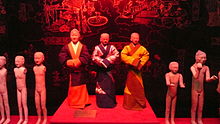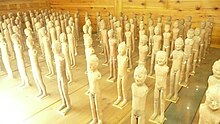Han Yang Ling
The Han Yang Ling mausoleum ( Chinese 漢陽陵 / 汉阳陵 , Pinyin Hàn Yáng líng ) is the tomb of Han Jingdi (188–141 BC), the fourth emperor of the Western Han Dynasty (202-16 BC). ). It is located in the Weicheng District of Xianyang City , 20 km north of the provincial capital Xi'an on the Wei River near Xi'an Xianyang Airport in the western Chinese province of Shaanxi . It is one of the " Five Mausoleums " of the Western Han Dynasty.
History, location and structure
The Han Yang Ling Imperial Mausoleum is the joint burial place of Emperor Jingdi (Liu Qi) and Empress Wang Zhi (Xiaojing). It was made in the period from 153 to 126 BC. Built on a total area of 20 square kilometers. It is the easternmost of the 9 of a total of 11 Han tombs, which were designed in the shape of a pyramid and are located on the Xianyang Plateau . In the center of the complex are the 32 m high pyramid of the emperor and the smaller pyramid of the empress with a height of 25 meters. In contrast to Egyptian pyramids, they are blunt and look like flat mounds of earth that were built from rammed earth. The circumference of the square base of the emperor's tomb is 670 meters; at the top the circumference is 238 meters. Around these graves there are 81 pits with grave goods and a total area of 7,000 m². A large number of other mounds represent graves of family members, officials or concubines. The tomb of Qin Shihuangdi served as a model for the construction of these Han pyramids, which together with the pyramids of the Tang dynasty represent an important part of the pyramids of China .
Han Yang Ling Museum
In 1990 pits with clay soldiers were discovered while the expressway from Xi'an to the new airport was being built. As a result, extensive archaeological investigations were initiated in 1991, which, however, have so far left the imperial burial mounds untouched. At the beginning of the 1990s, 24 pits were uncovered, in which 40,000 clay figures were found. In contrast to the terracotta army of Qin, they are only a third life-size, generally 62 cm high. The pits have a floor area of 96,000 square meters, which is five times the floor space of the terracotta army of the First Emperor of China.
The Han Yang Ling Museum opened in 1999 and is considered the largest underground museum in China. It is still in the shadow of the world-famous mausoleum of the First Emperor Qin Shihuangdi with the terracotta army, which is located in the east of Xi'an, although it already has more finds to offer and shows the culture of the Han dynasty like no other museum. The museum also offers a unique insight into the ongoing excavations in individual, true-to-original pits.
In a modern archaeological exhibition hall, around 1,700 objects are shown on two floors. The clay figures include not only warriors, but also servants, cattle dealers or accountants. Given the long time underground, the clothes and the movable wooden arms attached to the clay bodies are now rotten. Different animals such as horses, cows, chickens, pigs and dogs are also among the exhibits on display. These dogs are well represented because they were probably one of the emperor's favorite foods.
Insight into the excavations
Individual evidence
- ↑ Great success with the archaeological excavation of the Yangling Mausoleum from the Western Han Dynasty
- ↑ Jörg Dendl: The pyramids of Xian - China's enigmatic imperial tombs . In: Michael Haase (Ed.): Secrets, riddles, analyzes, solutions GRAL; Journal of Archeology and Frontier Archaeological Sciences . 11, Berlin, 1998, ISSN 0943-4070 .
- ↑ Information brochure HANYANGLING Museum 2008, English, Chinese
Web links
- Han Yang Ling Museum Official Website - English
- Youtube video about the Han Yang Ling Mausoleum
- Li Jiajun, Xi'an Jiaotong University: West Han Artifacts of Han Yangling Mausoleum Museum, Maoling Mausoleum Museum, and Xianyang Museum in Xi'an (English; PDF; 1.6 MB) (accessed July 25, 2011)
Coordinates: 34 ° 27 ' N , 108 ° 56' E








